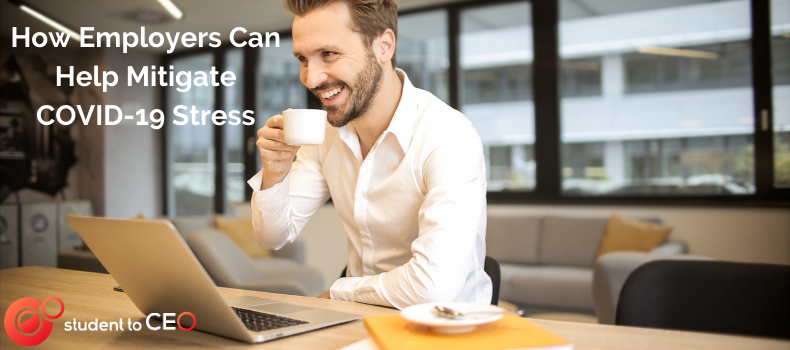It has been nine months since the pandemic first took hold of the world. Since then, many employers have adjusted their workplace strategies, many of which include having their employees work from home. Due to being out of the office for several months, many employees are hesitant to return to work inside an actual building.
Due to this mindset, employers should be mindful of the steps they can take to make their employees feel safe and reassured at their physical places of work. If you are an employer, please consider the following ways in which you can help mitigate COVID-19 stress.
Visible Cleaning
One of the best actions an employer can take is making routine daily cleanings mandatory during the day. This can be as simple as having employees wipe down their work stations before and after their shifts with disinfecting wipes or spray.
Additionally, you can schedule your janitorial staff to take their shifts throughout the day so that all sanitation procedures can be seen by your employees. Doing this will make workers feel more at ease knowing their place of work is constantly being cleaned. This will also help lessen the risk of contamination from high touch surfaces since items such as printers, copy machines, touch pads, door handles, light switches, and phones will frequently be cleaned.
Not to mention that keeping all bathrooms, break rooms, and kitchens in your place of work clean demonstrates your commitment to helping employees transition back smoothly and without fear into their workplace.

Sanitation Regulations
In order to effectively enforce routine cleanings for your company, you have to be sure that your facility is always fully stocked with sanitation items that your employees can use. Some items to consider having include:
- Sanitation wipes
- Disinfecting spray
- Paper towels
- Hand sanitizer
- Disposable gloves
- New reusable masks
- Soap
To make sanitation regulations more effective, also consider setting up hand sanitizer stations throughout the office or warehouse, especially in communal areas, such as in break rooms and near employee work stations, to promote good hygiene practices.

Spacing
When it comes to physical distancing, it is important to keep this practice ongoing throughout the workday. To help physically distance employees, you can organize work areas in a manner that allows them to remain six feet apart from one another if the space permits.
However, if you are in a small space and cannot physically keep everyone separated, then consider setting up plastic barriers between desks or offering face shields as an alternative. This way, you can help minimize the risk of close contact amongst employees.

Work Policies
One of the most important ways to make employees feel safe at work is putting in place new policies or revising existing policies regarding health and safety. You should have policies in place that address the following:
- Sickness: Require sick employees to stay home without penalties, especially if they are experiencing COVID-19 related symptoms, such as a fever, cough, or shortness of breath. Make sure employees understand sick leave policies and the symptoms that would require them to stay home.
- Accessory Restrictions: To reduce contact with high touch surfaces, require employees to leave unnecessary accessories such as jewelry, ties, and watches at home.
- Minimize Face to Face Contact: If possible, try to establish flexible work arrangements where employees can work from home on certain days or have staggered shifts to help reduce the amount of face-to-face contact with others. Additionally, consider having virtual meetings moving forward to help lower any risk of spreading contaminants.
- Ventilation: Keep a steady air flow to help ventilate your work facility. Do this by opening outside doors and windows as is deemed appropriate.
- Transportation: Encourage employees to come to work in their own vehicles and to constantly disinfect their automobiles. When it comes to public transportation, many times there is no room to physically distance, since there are multiple passengers on this transport option. Due to this, your employees can wind up getting sick or stressed out because their chance of getting sick is higher. To combat this, incentivize ride share options over public transportation by offering to pay for employees’ passage. Remind employees taking ride share options to use touchless payment, wear a mask and gloves, sit in the backseat, roll down car windows for ventilation, and wash their hands once they arrive at work to help keep themselves safe and healthy .For additional tips about transportation safety, click here.

Open Discussions
Even once these procedures are put into action, it can still be hard to gauge how your employees may be feeling. That is why it is highly recommended that you communicate openly with your workers. Employees should be communicated with frequently and asked for suggestions in regards to their current attitudes and emotions about new procedures. This constant dialogue will help bring a sense of ease back into the workplace, as employees will feel acknowledged and reassured when it comes to your concern about their safety and wellbeing.
This can be accomplished by hosting weekly or biweekly virtual meetings to discuss how everyone is adjusting to the changes in the workplace. You can also consider sending out a survey or questionnaire that can be answered anonymously online, in case some employees do not feel comfortable sharing their feelings publicly. Either way, both methods allow for an open discussion that everyone in the company can participate in and address any lingering concerns about returning to work.

As the head of a company, it is your duty to lead your company to success by putting your employees at the forefront of your business strategy so that they can succeed as well. That is why as an employer you must remember to be mindful of those people who work for you by doing your part to accommodate their health and safety concerns in regards to COVID-19 and returning to work. By following any of these tips, you will help ensure your employees to be at ease and mitigate their COVID-19 stress.



Leave a Reply